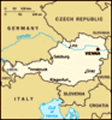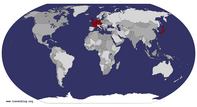Advertisement
Published: December 4th 2010
We checked out the hotel in Glaz on 28 September. We travelled to Salzburg by Austrian rail. There were beautiful scenery of mountains, lakes, and wooden houses along the route. We changed the train at Bischofshofen. There were views of snow-capped mountains beyond. The train was running upwards to Salzburg.
The hotel we booked in Salzburg is not far from the station, but I mistook the road, and it made us walk longer with big pieces of baggage.
After resting at the hotel for a while, we walked to the Old Town. It was colder in Salzburg in the late afternoon. After going down Reiner Strasse passing the Mirabell Garden, we crossed over the bridge, and entered the Old Town. I remembered the streets in Salzburg where I visited on my own 12 years ago. I showed Mark Getride Strasse with striking shop signs, Residentplatz, and Mozart statue.
Cemetery, St Peter's Church
We then approached the cemetery of St Peter's Church, which is one of the highlights in Salzburg. I explained to Mark that the cemetery was the final homes to well-known archbishops, artists, and politicians, and those graves have been taken care of by the Catholic worshippers.
He agreed that adornment on the graves, which include candles, mythological sculptures, and inscriptions, are different from ones that are looked after by English churches.
Afterwards, we strolled though narrow lanes in the Old Town. I told Mark that there are a lot of squares, stalls, and souvenir shops in Salzburg. I showed him the Old Market where dozens of traditional Austrian crafts, dolls, and ornaments are on sale. Sadly, they are quite expensive, and it's not always very easy to negotiate the shop assistants to reduce the price. There was a wide range of attractive items on sale at the gift shops and markets in Salzburg. I spotted at the salt shop, and bought a salt packet for cooking and bathing. We also
noted some shops selling snowmen, stars, hollies, and decorating items for Christmas trees.
Salzburg Restaurant
We browsed around the shops in the Old Town till 6pm, and decided to have dinner at the restaurant off Getride Strasse. It was a very big restaurant where it seemed over 300 diners could be accommodated and served. The decorations included sizeable paintings illustrating the old days of Salzburg, and surrounding countryside, and a horse carriage
decorated with colourful autumn vegetables, hays, and flowers. All waiters and waitresses were wearing in traditional Austrian costumes consisting of wait coasts, long skirts, and leather wallets. We were offered the menu in English. Mark ordered "trout with potatoes", and I chose "beef goulash and dumplings". I was offered homemade cranberry sauce. We were quite hungry in the evening on 28 September, after travelling up to Salzburg from Graz for 4 hours, and strolling through the Old Town. Mark had pancake with apricot jam, and I selected "sachetorte" Austrian chocolate cake.
Mozart Birthplace
We had discussed places to visit in Salzburg. After having breakfast at the hotel, we walked to the birth house of Wolfgang Amadeus Mozart, i.e. 9 Getride Strasse. There were several exhibition rooms displayed with portraits of the Mozart family and neighbours, music instruments, e.g. violin, recorder, piano, etc, handwritten compositions, stationery items, letters, and clothes, to name just a few. Wolfgang Amadeus Mozart possessed profound music talents from the very early age. Despite the fact he passed away in his mid thirties, the Mozart Museum curators have confirmed that he produced over 600 compositions and wrote approximately 30 operas in his life. No wonder Salzburg
has become so famous as the birthplace of Wolfgang Amadeus Mozart. We also looked round the additional exhibition rooms with the 18th century furniture, and bath & cosmetic items which the Mozart family used. Wolfgang Amadeus Mozart travelled a lot during his lifetime. There were a number of paintings of places where he visited, and documents related to his journeys displayed on the wall.
Festung Hohensalzburg
Next, we went to Festung Hohensalzburg. We got to the top by the funicular railway. The combined tickets allowed us to look round the Fortress Museum, displayed with a number of ceramics, earthenware, golden and silver items, archaeological collections which were discovered between 1993 and 1998, music instruments and armoury collection. We walked through the concert hall where the famous concert is held at the beginning of September annually, St George's Chapel, and Golden Room with the Gothic tiled stove, and golden decorations on the wall, ceiling, and sides of pews. The decorations on the 15th century stove in the Golden Room is one of the most vivid stoves in the world. There are figures of different types of expressions, many carvings of creatures attached on the grid patterns on the surface.
In contrast to the rather gloomy evening on the previous day, it turned much brighter in Salzburg on Saturday, 29 September. I had great pleasure in showing Mark the beautiful countryside with Alps on the south side and stunning Old Town on the north side. We had no hesitation in choosing the beer garden restaurant and sitting by the balcony for lunch. Mark had goulash soup, and I ordered sausage selection with potatoes and cabbage. Mark felt the goulash soup contained many pieces of meats and vegetables, and was quite filling. I was offered five different types of sausages including Frankfurter, and white sausage containing herbs. I gave some pieces of sausage to Mark.
After the lunch, I found the entrance area for the inner rooms of Fortress. Our combined tickets covered this building. The receptionists controlled the numbers of people to enter the building; thereby we waited for a little while. After hiring English audioguides, we went to the main reception room where portraits of archbishops from 11th to 19th century hanging on the wall. Below the portraits there were architectural models showing the development and expansion of the Fortress from time to time. It was interesting to
learn that the Fortress was used for storing salt, and Salzburg's economy was developed by the prosperity of salt trading. We looked round the torture room, and then climbed on spiral steps to the top of the tower. We were offered the splendid panoramic view of the Old Town, countryside, and Alps under the blue sky. I took quite few pictures while standing on the top of the balcony.
Afterwards, we walked down to the Old Town via the footpath. For the birthplace of Wolfgang Amadeus Mozart, it seems to me that Salzburg has become one of the major tourists' destinations in Austria. We saw loads of different types of Mozart chocolates, and a bewildering array of crafts, clothes, paintings, accessories, and stationery items here and there, and they were all tempting to me. I bought some souvenirs for my in-laws.
Michael Haydn's Museum
Mark spotted Michael Haydn's museum near St Peter's church on the previous day. Compared to Mozart's house, Michael Haydn's museum was rather small but quite interesting. We looked at several pieces of memorabilia, music instruments, and handwritten compositions. The audiovisual film showed Michael Haydn's life involving music career, and his work with Mozart. He
is younger brother of Joseph Haydn, and
lived in Salzburg for 40 years. Mark bought a CD "Michael Haydn's symphonies".
Salzburg Cathedral
Finally, we went to the Dom or Salzburg Cathedral. Quite a few tourists were visiting the Dom in the late afternoon. We were impressed with the rich stucco decorations and frescos on the wall and vault, and the images of "The Resurrection of Christ" on the main altar, all of which seemed to have been restored recently. I inserted 1 Euro coin into the donation box. The lady who was in charge of the donation box gave us pleasant response. She offered us English commentary cards of Salzburg Cathedral with details of its history.
Mirabell Garden
Apart from the Mirabell Garden, all tourist attractions are standing on the south bank of the river in Salzburg. I had therefore planned exploring the Mirabell Garden on Sunday morning on 20 September before travelling to Nurnberg. The receptionists let us leave our big pieces of luggage at Markus Sittikus Hotel.
After leaving the luggage, we headed for the Mirabell Garden. It was peaceful and quiet when we arrived at the Mirabell Garden. The garden was designed by Archbishop
Wolf Dietrich. Formal gardens, consisting of roses, borders with pink and red begonias, lavenders, different types of sculptures, ornaments, and fountains, were just wonderful. They looked even more attractive and colourful, together with autumn
coloured leaves on trees, shrubs, and climbing foliage. We also enjoyed its atmosphere and setting which offered the breathtaking view of the Old Town, Hohensalzburg, Mirabell Church, and Alps. Mark spotted the greenhouse, which was home to sub-tropical plants, red and yellow chillies, and parrots.
He was interested in marble dwarf statues, which were designed by Archbishop Franz Anton Furst Harrach and laid in a circle. Each of them has distinctive features, and shows a wide variety of expressions. A lot of people came to the Mirabell Garden as the time went by. We really enjoyed exploring the Mirabell Garden viewing colourful flowers, touching interesting sculptures and ornaments, together with the fine weather.
Advertisement
Tot: 0.065s; Tpl: 0.012s; cc: 14; qc: 31; dbt: 0.0406s; 1; m:domysql w:travelblog (10.17.0.13); sld: 1;
; mem: 1.1mb










